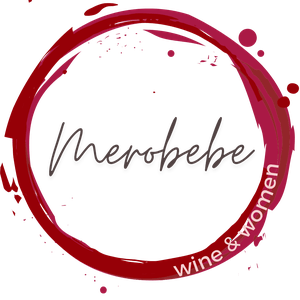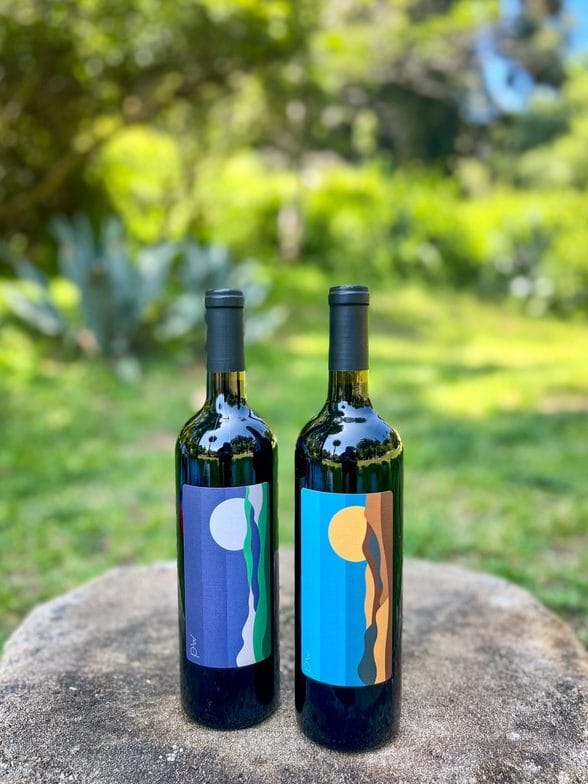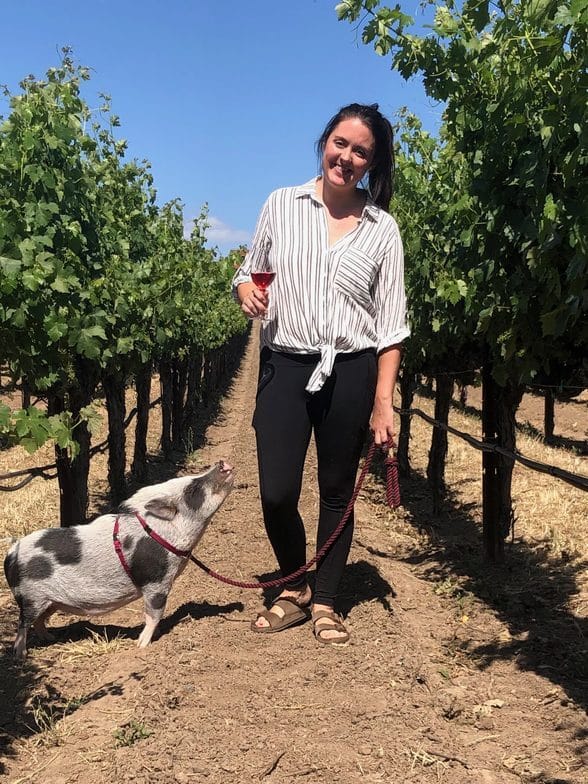
Happy Wine Wednesday!
And today is an extra special Wine Wednesday because I have a 20% discount for wine just for you!
This week’s issue comes to your inbox in partnership with Panoramic Wines, a queer-owned and family-run winery in the Alexander Valley. We’ll be diving into cabernet franc with co-owner Corey Braccialini, then chatting with their assistant winemaker, Alexandra Young.
So pour yourself a glass and get ready to sip on some amazing cabernet franc!

Cabernet Franc
A Superstar in a Supporting Role
You obviously know cabernet sauvignon, but you might not be as familiar with cabernet franc. Usually found in blends, this grape is the parent of cabernet sauvignon (along with sauvignon blanc), but it’s often getting overshadowed by the rest of its family. Think of cab franc like the lesser known Hemsworth. Even though it’s not a household name, cab franc can shine all by itself!
Even though it’s the parent of cabernet sauvignon and shares half of its name, the two are quite different. Here’s Corey Braccialini, co-owner of Panoramic Wines, with their key differences:
“Wines made from cabernet sauvignon tend to lean towards full body, high acidity, and black fruit flavors, although it can be made into somewhat lighter styles like ours. Cabernet franc, on the other hand, has a softer and more aromatic profile with a medium body and acidity, and flavors of red fruits and savory herbs.”
They’re not totally different, though! One note that cab franc and cab sauv do have in common is “green bell pepper.”
Remember how we talked about sauvignon blanc being “grassy” and “green” in a previous issue? The compound responsible for making sauvignon blanc “green,” called methoxypyrazine, can also be found in cabernet franc and cabernet sauvignon (reminder: sauvignon blanc and cabernet franc are the parents of cabernet sauvignon, which emerged in Bordeaux, France in the mid-1600’s).
The varietal can also change based on where it's grown, so let’s take a look at where you might find cabernet franc around the globe!
The red grape is originally from Bordeaux, France where it is one of the five major varietals in Bordeaux blends (along with cabernet sauvignon, merlot, malbec, and petit verdot). It’s often viewed as the star of the Loire Valley, where you'll find beautiful, lighter cab francs with notes of raspberry and roasted red pepper in Chinon and Bourgueil (pronounced bore-GOY), neighboring appellations in the heart of the valley. Some well-known producers from Chinon and Bourgueil that have delicious wines for $30 or less include Château de la Grille, Domaine Dozon, and Domaine les Pins.
In Italy, the second largest producer of cab franc, you’ll find the varietal in Friuli-Venezia Giulia (a wine region in the northeast bordering Austria and Slovenia) and, more popularly, in Tuscany where they’re blended in Super Tuscans. Many of the Super Tuscans from the Bolgheri DOC (wine region) are based on cab franc and you’ll get rich aromas of black cherry, cocoa, and hints of leather from these blends.
If you’re looking for a nice, expensive bottle of wine for a gift or celebration (or just because), check out Sassicaia by producer Tenuta San Guido from the Bolgheri region. This is a blend of cab franc and cabernet sauvignon, but I can’t mention cab franc Super Tuscans and not include Sassicaia!
Considered an influential Super Tuscan, Sassicaia was first produced in 1948 as a family wine before being released commercially from its 1968 vintage. It’s now the only wine from a single estate in Italy that has been granted its own DOC as Bolgheri Sassicaia DOC. It’s made from a blend of cabernet sauvignon and cabernet franc and is A Big Deal! Expect to spend ~$200+.
Stateside, you’ll find cab francs on the east coast in New York and Virginia, in Washington, and in California – typically as a blending component in Napa Valley cabernet sauvignons. The cabernet franc in New York, especially on Long Island and in the Finger Lakes, is becoming more and more popular. Try RGNY’s cabernet franc from the North Folk of Long Island made by female winemaker Lilia Perez for $30-$35!
The varietal is also gaining traction in Chile, which has just recently started producing single-varietal cabernet franc wines. If you want to take a dive into a Chilean cab franc, try one from the Colchagua Valley where you can spend around $30 for a delicious bottle with bursts of acidity, juicy berries, and aromas of chocolate and green peppercorn.
Even though it’s not the most popular grape, cab franc plays an important role in wine throughout the world - as a blending grape, solo wine, and as the parent of other popular wine grape varietals! We already know about cab sauv, and it’s also the parent of merlot and carménère. (Maybe the Hemsworth comparison wasn’t quite distinguished enough…)
In addition to being delicious, cab francs are also great pairing wines and can be enjoyed with a variety of dishes depending on where it was made.
Try pairing your cab francs with tomato-based dishes like pasta sauces, with rich veggies like lentils, or a vinegar-based BBQ! It’ll also pair perfectly with dishes with herbal sauces or fresh herbs. Depending on the style of your cabernet franc, you’ll also be able to experiment with pairing your wine with anything from goat’s cheeses, eggplant parmesan, to roasted meats.
In case I haven’t been able to convince you on why you should try a 100% cabernet franc, I’ll let Corey finish this off for you:
“Candidly, cabernet franc is one of my favorite varietals. Its flavor profile gives it a lot of range and flexibility to be made into many styles, such as sparkling wines, roses, light-bodied reds, and more complex reds. We knew bottling our cab franc as a single-varietal wine would result in the kind of wine we like to drink, and the kind of wine folks might not expect to see from the Napa and Sonoma area. We want our wines to be authentically themselves, challenge expectations, and foster connection, so bottling 100% cab franc was a no-brainer for us.”

Panoramic Wine's 2019 Cabernet Franc
Keep reading for a 20% discount on your next California cabernet franc…

Established in 2018 by father and son team Scott and Corey Braccialini, Panoramic Wines is a small, queer-owned and family-run winery that partners with local, sustainable farmers to create their wines. With a mission to create limited-run wines that embody a unique sense of place, they use a light-handed winemaking style to let the grape speak for themselves.

This year, they released a beautiful cabernet franc and cabernet sauvignon from their family vineyard (literally - look how beautiful those labels are! Hats off to Corey who also designed the label-art).
After using techniques to slow down the ripening of the grapes for more concentrated flavors, all of the cab franc grapes were hand-picked on September 26, 2019 before being crushed, destemmed, then cold soaked for 3 days. The wine then aged in a neutral French oak barrel for 22 months, finished in new French oak, and was finally bottled unfined and unfiltered in August 2021 - meaning no additives!
Only 24 cases of the cab franc were produced, so this special wine is of extremely limited quantity. Lucky for us, Corey is extending a discount to the Merobebe community!
Use the code “Merobebe” to save 20% on your order of 3+ bottles of wine – plus get free shipping!
Take advantage of the discount and get some wine for your summer BBQs here.

Alex Young
Assistant Winemaker at Judd’s Hill and Panoramic Wines
This interview has been edited for clarity.
Merobebe
If you could visit any wine region in the world, where would you go?
Alex Young
Wow! Super hard choice, but I would absolutely love to visit Italy to sit down and have a glass with a small-town producer. To listen to their story about their family’s history in winemaking and the philosophy behind their winemaking choices. I think the difference between textbook winemaking and familial secrets passed down from generation to generation is so fascinating. Both produce phenomenal wines but I really geek out on the differences between the two.
MerobebeIf you could have any superpower related to wine, what would it be?
Alex YoungI would love to be able to be an accurate human analysis machine – be able to taste anything and articulate accurate lab reports. First off, the money saved on labs would be astronomical. But secondly, the amount of guesswork that it would take out of day-to-day cellar activity would be awesome. Also; bragging rights.
MerobebeI'm so jealous that you grew up with a sommelier mom! When you were younger, did your family often talk about wine at home or discuss what you were drinking with dinner?
Alex YoungYes, my family often talked about wine while I was growing up. One of the earliest memories I have of wine is my mom teaching me to detect cork taint around age 6. She even put damp newspapers into a Tupperware and let them mold so I could smell the “moldy newspaper” and pick it up in wine. Her favorite party trick (while hosting International Wine & Food Society dinner parties) was to hand me a glass of wine to smell and have me inevitably say “ew, that’s corked” to all of her wine club friends who hadn’t previously detected the TCA [the acronym for the compound causing cork taint]. About 90% of them would agree it was tainted after I gave my official declaration.
MerobebeYou grew up in the Reno/Tahoe area and migrated towards Napa. What initially drew you to winemaking there?

Alex takes a vineyard stroll with her pet pig, Pinot
Alex YoungI had been lucky enough to visit when I was younger (with my mom of course), and after she moved down to Napa I spent a couple of years working in the restaurant scene and learning more about wine before moving back to Reno for almost 7 years.
I continued working in restaurants and bars back in Reno, learning more about beer and wine, and in 2017 I decided I wanted to take a little hiatus from the service industry and take a deeper dive into how wine was made. So I applied for a couple of internships and landed at Judd's Hill for a harvest winemaking internship.
MerobebeComing from the service side of the wine industry, what was the most surprising aspect of harvesting and winemaking for you?
Alex YoungThe absolute most surprising thing for me was the realization of how much of an agricultural product wine is. It was never something really thought of, pouring a glass of elegant Pinot Noir or crisp Sauvignon Blanc for a table. I don’t think I ever would have connected how much wine truly comes from the vineyard until I saw grapes come in with part of the vineyard on them; including ants, dust, grape leaves, etc. And then seeing fresh-pressed grape juice looking like something from a juice bar with skins floating around in it.
Then throughout the whole process, it slowly started to take the shape of the end product I was so familiar with. It was truly an eye-opening experience that first year to watch sticky grapes fresh from the vineyard transform into a glass of rosé I could enjoy on the patio.
MerobebeWhat are your favorite (and least favorite) aspects of wine making?
Alex YoungI think my favorite and simultaneously least favorite aspect of winemaking is working with what Mother Nature has to offer for that particular vintage. Some vintages offer up perfect grape growing conditions with the ability to call all your picks at the perfect ripeness and even luck out finding a last-minute vineyard that has extra grapes from a varietal that you’ve always wanted to work with.
But sometimes you are offered sweltering heat waves, with vineyards that get much riper than you would ever want, leading to high alcohol and stuck fermentations. Or vineyards that are coming in at a quarter of the tonnage you were expecting. What’s cool about both the good and the bad is that they tell a story of the vintage and both make for truly unique and delicious wine.
MerobebeTell us a little bit about the custom crush process. How does that work?
Alex YoungCustom crush varies throughout the industry. There are some established wine labels that do not actually own their own wine making facilities, but instead turn to custom crush houses to make wine for them.
And then there is what we do at Judd’s Hill which is custom crush on a “Microcrush” scale. We will have families bring us grapes from either their backyards or from their family-run vineyards and make them their own custom barrel of wine from start to finish. Most places have a minimum requirement of at least 3-4 barrels worth of wine but we only ask for about half a ton of fruit which is a single barrel.
From there, we make each of our clients their custom wine exactly to their specifications. Some just want wine to share with friends and family over the holidays, and others are starting their own small brands to promote the grapes that their families have been growing and selling for years. Our clients range from being completely hands-off and just picking up the final product once it’s bottled, to those who are actively producing the wines with us. No matter what level of involvement they have, everyone ends up with the type of wine they want and love.
Working in custom crush has been one of the best educational experiences for me because I get to see a massive amount of different varietals and winemaking styles, and I have been able to learn from the grapes as well as my mentor, Eric Lyman.
MerobebeIf you had all of the money in the world...what kind of wine would you make?
Alex YoungI would make wine for friends, family, and fellow wine nerds who want to drink unique varietals from forgotten vineyards and enjoy what story each vintage has to tell. Wine made for the masses can be wonderful but also limiting. You have to make the same product year after year because people want their wine to taste exactly like what they are expecting.
I want to make wine that makes you think and talk about it with your friends at a backyard BBQ. Or a wine that you bring to stump all of your friends at a blind tasting group. Ultimately, I want to make wine to just enjoy.

Get a wine-related movie or book pairing for your weekend.
Today’s pairing is Eight Hundred Grapes by New York Times bestselling author Laura Dave.
“Impossible to put down” (Elle) and “addictive” (Us Weekly) are just some of the raving reviews for this heartbreaking yet funny novel about love, family, and wine. The story follows Georgia Ford, a bride-to-be, who makes the long drive home to her family’s winery in Sonoma after discovering a life-changing secret about her fiancé. Even though she’s hoping to find comfort (and distraction) from her family during the vineyard’s last harvest, she quickly realizes that her family has also been keeping things from her.

Get ready to spend all day on the couch with this page turner (and some wine) and join Georgia on her discovery of the messiness of life and love.
Reply to this email and share your favorite wines or burning wine questions with me
Plus, hitting reply helps email providers know that Merobebe is a safe sender/friend/not spam so thank you in advance for your email!
Have a wine-derful week, don’t forget to save 20% on your Panoramic Wines, and see you next Wednesday!
Cheers,
Megumi
Have questions or feedback? Want to suggest a wine topic, woman in wine, or vinotainment pairing? Just reply to this email!




Copyright (C) " target="_blank">unsubscribe
